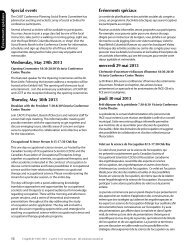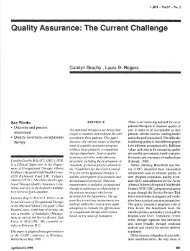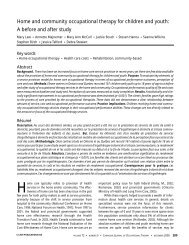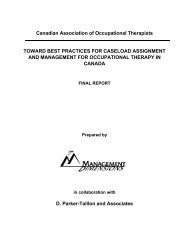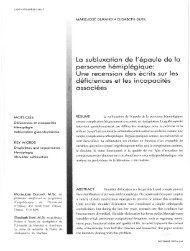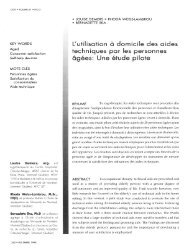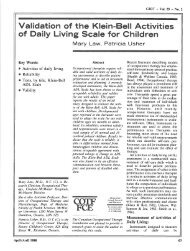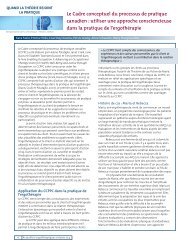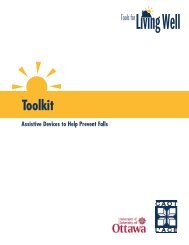Reflections on the past ten years of occupational therapy in Canada
Reflections on the past ten years of occupational therapy in Canada
Reflections on the past ten years of occupational therapy in Canada
Create successful ePaper yourself
Turn your PDF publications into a flip-book with our unique Google optimized e-Paper software.
6<br />
<str<strong>on</strong>g>Reflecti<strong>on</strong>s</str<strong>on</strong>g> <strong>on</strong> <strong>the</strong> <strong>past</strong> <strong>ten</strong> <strong>years</strong> <strong>of</strong><br />
occupati<strong>on</strong>al <strong>the</strong>rapy <strong>in</strong> <strong>Canada</strong><br />
Lynn Cockburn<br />
Mix toge<strong>the</strong>r <strong>ten</strong> <strong>years</strong>, thousands <strong>of</strong> dedicated<br />
occupati<strong>on</strong>al <strong>the</strong>rapists, countless great occupati<strong>on</strong>allybased<br />
ideas with complex and ever-chang<strong>in</strong>g political, health<br />
and social c<strong>on</strong>texts, and <strong>the</strong> outcome is <strong>the</strong> evolv<strong>in</strong>g field<br />
<strong>of</strong> occupati<strong>on</strong>al <strong>the</strong>rapy from 2001 - 2010. What was <strong>on</strong>ce<br />
called <strong>the</strong> “diffident pr<strong>of</strong>essi<strong>on</strong>” (Maxwell & Maxwell, 1978) is<br />
<strong>in</strong>creas<strong>in</strong>gly mak<strong>in</strong>g its presence felt <strong>in</strong> a variety <strong>of</strong> sectors and<br />
spheres across <strong>the</strong> country and around <strong>the</strong> world.<br />
In 2001, Helene Polatajko wrote:<br />
With our new enablement perspective, our challenge is<br />
to learn to fully understand <strong>the</strong> occupati<strong>on</strong>al human and<br />
<strong>the</strong> nature <strong>of</strong> enablement, to push forward a science <strong>of</strong><br />
occupati<strong>on</strong> <strong>in</strong> c<strong>on</strong>juncti<strong>on</strong> with a science <strong>of</strong> enablement.<br />
…our opportunity and our privilege will be to enable<br />
<strong>the</strong> occupati<strong>on</strong> <strong>of</strong> all people, to go bey<strong>on</strong>d <strong>the</strong> medical<br />
missi<strong>on</strong> <strong>of</strong> preserv<strong>in</strong>g life to enabl<strong>in</strong>g liv<strong>in</strong>g (Polatajko,<br />
2001).<br />
This paper provides some<br />
observati<strong>on</strong>s <strong>on</strong> <strong>the</strong> last <strong>ten</strong><br />
<strong>years</strong> <strong>of</strong> Canadian occupati<strong>on</strong>al<br />
<strong>the</strong>rapy; I c<strong>on</strong>sider some <strong>of</strong> <strong>the</strong><br />
emerg<strong>in</strong>g trends and <strong>the</strong>mes as <strong>the</strong><br />
pr<strong>of</strong>essi<strong>on</strong> has grappled with this<br />
challenge. My writ<strong>in</strong>g is not based<br />
<strong>on</strong> a formal study, but ra<strong>the</strong>r is a<br />
reflective piece highlight<strong>in</strong>g some<br />
<strong>of</strong> <strong>the</strong> experiences and issues <strong>of</strong><br />
this decade. As an educator and<br />
academic, I work <strong>in</strong> an envir<strong>on</strong>ment<br />
where we notice what people<br />
are writ<strong>in</strong>g and talk<strong>in</strong>g about, we<br />
have discussi<strong>on</strong>s with colleagues<br />
formally and <strong>in</strong>formally. In additi<strong>on</strong><br />
to my pers<strong>on</strong>al reflecti<strong>on</strong>s, I<br />
reviewed <strong>the</strong> Canadian Journal <strong>of</strong><br />
Occupati<strong>on</strong>al Therapy (CJOT),<br />
OT Now, c<strong>on</strong>ference proceed<strong>in</strong>gs,<br />
and several websites.<br />
OCCUPATiONAL THERAPy NOW VOLUmE 13.1<br />
The Canadian c<strong>on</strong>text and <strong>the</strong> Canadian<br />
Associati<strong>on</strong> <strong>of</strong> Occupati<strong>on</strong>al Therapists<br />
Dur<strong>in</strong>g this <strong>past</strong> decade, <strong>in</strong>dividual occupati<strong>on</strong>al <strong>the</strong>rapists,<br />
as well as local, prov<strong>in</strong>cial, regi<strong>on</strong>al and nati<strong>on</strong>al groups<br />
were active <strong>in</strong> resp<strong>on</strong>d<strong>in</strong>g to <strong>the</strong> needs <strong>of</strong> Canadians and<br />
to opportunities to <strong>in</strong>fluence healthcare, social services,<br />
and educati<strong>on</strong> systems. The Canadian Associati<strong>on</strong> <strong>of</strong><br />
Occupati<strong>on</strong>al Therapists (CAOT) c<strong>on</strong>t<strong>in</strong>ued to take a<br />
leadership role with<strong>in</strong>, and external to, <strong>the</strong> occupati<strong>on</strong>al<br />
<strong>the</strong>rapy community, and collaborated with a wide range <strong>of</strong><br />
nati<strong>on</strong>al organizati<strong>on</strong>s with shared comm<strong>on</strong> goals (CAOT,<br />
2010). For example, <strong>the</strong> Canadian healthcare landscape was<br />
<strong>in</strong>fluenced by <strong>the</strong> Commissi<strong>on</strong> <strong>on</strong> <strong>the</strong> Future <strong>of</strong> Health Care <strong>in</strong><br />
<strong>Canada</strong> (The Romanow Commissi<strong>on</strong>, 2002) and <strong>the</strong> Mental<br />
Health Commissi<strong>on</strong> <strong>of</strong> <strong>Canada</strong> (2008), both <strong>of</strong> which received<br />
occupati<strong>on</strong>al <strong>the</strong>rapy submissi<strong>on</strong>s and <strong>in</strong>volvement (CAOT,<br />
2001; CAOT, 2009).<br />
Educati<strong>on</strong><br />
Dur<strong>in</strong>g this decade, educati<strong>on</strong>al<br />
programs grew from twelve to<br />
fourteen accredited Canadian<br />
occupati<strong>on</strong>al <strong>the</strong>rapy schools <strong>in</strong><br />
<strong>Canada</strong>. The two new programs<br />
are at <strong>the</strong> Université du Québec <strong>in</strong><br />
Trois Rivières and <strong>the</strong> University <strong>of</strong><br />
Sherbrooke.<br />
In 2002, CAOT published<br />
a Positi<strong>on</strong> Statement <strong>on</strong> Entry-<br />
Level Educati<strong>on</strong> <strong>of</strong> Occupati<strong>on</strong>al<br />
Therapists <strong>in</strong> <strong>Canada</strong> (CAOT,<br />
2002) which stated that effective<br />
<strong>in</strong> 2008, <strong>on</strong>ly programs lead<strong>in</strong>g<br />
to a pr<strong>of</strong>essi<strong>on</strong>al Master’s degree<br />
<strong>in</strong> occupati<strong>on</strong>al <strong>the</strong>rapy would be<br />
granted academic accreditati<strong>on</strong>.<br />
Although <strong>the</strong> move to Master’s<br />
level educati<strong>on</strong> created<br />
c<strong>on</strong>siderable discussi<strong>on</strong> and some<br />
c<strong>on</strong>troversy, by 2010, all fourteen<br />
university programs <strong>in</strong> <strong>Canada</strong>
had Master’s programs well underway (Associati<strong>on</strong> <strong>of</strong> Canadian<br />
Occupati<strong>on</strong>al Therapy University Programs, 2010).<br />
<strong>in</strong>terpr<strong>of</strong>essi<strong>on</strong>al teams<br />
Occupati<strong>on</strong>al <strong>the</strong>rapists have always been team players with<br />
a history <strong>of</strong> <strong>in</strong>terpr<strong>of</strong>essi<strong>on</strong>al educati<strong>on</strong> and practice. In <strong>the</strong><br />
<strong>past</strong> decade, grants and projects brought <strong>in</strong>terpr<strong>of</strong>essi<strong>on</strong>al<br />
educati<strong>on</strong> and <strong>in</strong>terpr<strong>of</strong>essi<strong>on</strong>al care <strong>in</strong>to <strong>the</strong> foreground <strong>of</strong><br />
practice. Health care sett<strong>in</strong>gs and governments across <strong>Canada</strong><br />
picked up <strong>on</strong> <strong>the</strong> importance <strong>of</strong> promot<strong>in</strong>g <strong>in</strong>terpr<strong>of</strong>essi<strong>on</strong>al and<br />
collaborative practice <strong>in</strong> primary<br />
care (EIPC, 2006) and o<strong>the</strong>r<br />
sett<strong>in</strong>gs (Health <strong>Canada</strong>, 2010;<br />
Paters<strong>on</strong>, Medves, Chapman,<br />
Verma, Broers, & Schroder,<br />
2007).<br />
Occupati<strong>on</strong>al <strong>the</strong>rapy<br />
examples <strong>of</strong> promot<strong>in</strong>g <strong>in</strong>terpr<strong>of</strong>essi<strong>on</strong>al teams <strong>in</strong>clude;<br />
Interdiscipl<strong>in</strong>ary Primary Health Care: Assembl<strong>in</strong>g <strong>the</strong> Pieces<br />
(McColl & Dickens<strong>on</strong> 2009), which walks <strong>in</strong>terested <strong>the</strong>rapist<br />
through <strong>the</strong> process <strong>of</strong> becom<strong>in</strong>g part <strong>of</strong> a primary care team;<br />
and that occupati<strong>on</strong>al <strong>the</strong>rapy was added to <strong>the</strong> fundable list<br />
<strong>of</strong> <strong>in</strong>terdiscipl<strong>in</strong>ary health providers for family health teams<br />
<strong>in</strong> Ontario (Ontario M<strong>in</strong>istry <strong>of</strong> Health and L<strong>on</strong>g Term Care,<br />
March 2010).<br />
Occupati<strong>on</strong>ally-based practice<br />
Increased focus and understand<strong>in</strong>g <strong>of</strong> <strong>the</strong> c<strong>on</strong>cept <strong>of</strong> occupati<strong>on</strong><br />
as foundati<strong>on</strong>al to <strong>the</strong> practice <strong>of</strong> client-centred occupati<strong>on</strong>al<br />
<strong>the</strong>rapy was evident <strong>in</strong> c<strong>on</strong>ferences, presentati<strong>on</strong>s, books,<br />
practice tools and methods over <strong>the</strong> last <strong>ten</strong> <strong>years</strong>. A special<br />
issue <strong>of</strong> CJOT highlighted ‘occupati<strong>on</strong>’ <strong>in</strong> December 2004.<br />
The Canadian Society <strong>of</strong> Occupati<strong>on</strong>al Science (CSOS)<br />
formed, generat<strong>in</strong>g ref<strong>in</strong>ements and reappraisals <strong>of</strong> exist<strong>in</strong>g<br />
models <strong>of</strong> occupati<strong>on</strong> and practice, and creat<strong>in</strong>g new models<br />
that positi<strong>on</strong> occupati<strong>on</strong> as a foundati<strong>on</strong> to occupati<strong>on</strong>al <strong>the</strong>rapy<br />
practice. This shift has called <strong>on</strong> <strong>the</strong> pr<strong>of</strong>essi<strong>on</strong> to be more<br />
critical and reflective <strong>in</strong> exam<strong>in</strong><strong>in</strong>g <strong>the</strong> exist<strong>in</strong>g assumpti<strong>on</strong>s and<br />
models (e.g., Cheng, 2010; Hammell, 2009; Iwama, 2006; Leclair,<br />
2010). Mean<strong>in</strong>g as an <strong>in</strong>tegral aspect <strong>of</strong> occupati<strong>on</strong> was explored<br />
and became more prom<strong>in</strong>ent with<strong>in</strong> research and practice<br />
(Doble and Santha, 2008; Hammell, 2004).<br />
A new vocabulary <strong>of</strong> occupati<strong>on</strong>ally centred terms and<br />
c<strong>on</strong>cepts emerged dur<strong>in</strong>g <strong>the</strong> <strong>past</strong> decade. For example,<br />
<strong>the</strong> <strong>in</strong>dex <strong>of</strong> Enabl<strong>in</strong>g Occupati<strong>on</strong> II <strong>in</strong>cludes at least 30<br />
such terms, from occupati<strong>on</strong>al alienati<strong>on</strong> and occupati<strong>on</strong>al<br />
apar<strong>the</strong>id to occupati<strong>on</strong>al well-be<strong>in</strong>g (Townsend & Polatajko,<br />
2007). Occupati<strong>on</strong>al <strong>the</strong>rapists became more engaged <strong>in</strong> this<br />
occupati<strong>on</strong>al discourse, and hallway c<strong>on</strong>versati<strong>on</strong>s, discussi<strong>on</strong>s,<br />
webpages, and writ<strong>in</strong>gs flourished across <strong>the</strong> country.<br />
“What was <strong>on</strong>ce called <strong>the</strong> ‘diffident pr<strong>of</strong>essi<strong>on</strong>’<br />
(Maxwell and Maxwell, 1978) is <strong>in</strong>creas<strong>in</strong>gly mak<strong>in</strong>g its<br />
presence felt <strong>in</strong> a variety <strong>of</strong> sectors and spheres across<br />
<strong>the</strong> country and around <strong>the</strong> world. ”<br />
Evidence-based practice<br />
Recogniti<strong>on</strong> developed that <strong>the</strong>re are diverse ways <strong>of</strong><br />
understand<strong>in</strong>g and develop<strong>in</strong>g <strong>the</strong> pr<strong>of</strong>essi<strong>on</strong>’s knowledge base.<br />
The focus <strong>on</strong> us<strong>in</strong>g evidence to improve outcomes, which was<br />
evident <strong>in</strong> <strong>the</strong> 1990’s through <strong>in</strong>itiatives such as <strong>the</strong> Canadian<br />
Occupati<strong>on</strong>al Therapy Foundati<strong>on</strong>’s Outcomes That Matter<br />
projects, c<strong>on</strong>t<strong>in</strong>ued <strong>in</strong> this decade. In 2001, CJOT and OT<br />
Now were filled with <strong>in</strong>formati<strong>on</strong> about develop<strong>in</strong>g and us<strong>in</strong>g<br />
evidence (Townsend & Rebieiro, 2001; Egan, 2001; CAOT<br />
Positi<strong>on</strong> Paper, 2001). In December <strong>of</strong> 2005, CJOT published a<br />
special issue <strong>on</strong> outcomes that<br />
addressed a range <strong>of</strong> practice<br />
sett<strong>in</strong>gs and populati<strong>on</strong><br />
groups, and <strong>in</strong>cluded a<br />
bibliography <strong>of</strong> relevant papers<br />
(Backman, 2005). Texts such<br />
as Interventi<strong>on</strong>s, Effects, and<br />
Outcomes <strong>in</strong> Occupati<strong>on</strong>al Therapy by Law and McColl (2009)<br />
provided fur<strong>the</strong>r directi<strong>on</strong> <strong>in</strong> us<strong>in</strong>g evidence. Many occupati<strong>on</strong>al<br />
<strong>the</strong>rapists explored ways <strong>of</strong> diversify<strong>in</strong>g and us<strong>in</strong>g creative<br />
arts and o<strong>the</strong>r forms <strong>of</strong> evidence <strong>in</strong> <strong>the</strong>ir practices (e.g., Dam,<br />
Fryszberg, & Kirsh, 2008; Trentham, 2010; Cheng, 2010).<br />
The occupati<strong>on</strong>al <strong>the</strong>rapy workplace<br />
Occupati<strong>on</strong>al <strong>the</strong>rapists worked with an expand<strong>in</strong>g range <strong>of</strong><br />
people with<strong>in</strong> a grow<strong>in</strong>g number sett<strong>in</strong>gs. Dur<strong>in</strong>g this decade,<br />
more occupati<strong>on</strong>al <strong>the</strong>rapists began work<strong>in</strong>g <strong>in</strong> private practices<br />
<strong>of</strong> various k<strong>in</strong>ds, with fund<strong>in</strong>g com<strong>in</strong>g from public and private<br />
sources. More at<strong>ten</strong>ti<strong>on</strong> was given to workplaces and return-towork<br />
c<strong>on</strong>cerns, <strong>in</strong>clud<strong>in</strong>g mental health and cognitive issues.<br />
The ways that occupati<strong>on</strong>al <strong>the</strong>rapists worked were also<br />
transformed by <strong>the</strong> <strong>in</strong>creased use <strong>of</strong> technologies: computers,<br />
Internet, emails, and handheld pers<strong>on</strong>al electr<strong>on</strong>ic devices, to<br />
name a few. An ever <strong>in</strong>creas<strong>in</strong>g range <strong>of</strong> adaptive equipment<br />
and devices became part <strong>of</strong> everyday practice. Polgar described<br />
<strong>the</strong> many uses <strong>of</strong> different k<strong>in</strong>ds <strong>of</strong> technologies <strong>in</strong> 2002 <strong>in</strong> her<br />
Muriel Driver lecture. CAOT’s website c<strong>on</strong>t<strong>in</strong>ued to be a key<br />
resource for occupati<strong>on</strong>al <strong>the</strong>rapists and for <strong>the</strong> general public,<br />
and changed its look <strong>in</strong> 2010.<br />
The challenge <strong>of</strong> go<strong>in</strong>g bey<strong>on</strong>d a medical perspective to<br />
enabl<strong>in</strong>g mean<strong>in</strong>gful occupati<strong>on</strong>s and fully engaged liv<strong>in</strong>g<br />
for all populati<strong>on</strong>s was evident <strong>in</strong> <strong>the</strong>ory and <strong>in</strong> pr<strong>of</strong>essi<strong>on</strong>al<br />
documents. Different opportunities to enable <strong>the</strong> occupati<strong>on</strong> <strong>of</strong><br />
more people were identified and realized bey<strong>on</strong>d <strong>the</strong> traditi<strong>on</strong>al<br />
sett<strong>in</strong>gs <strong>of</strong> rehabilitati<strong>on</strong> facilities and hospitals. Work is be<strong>in</strong>g<br />
d<strong>on</strong>e to c<strong>on</strong>nect general health and social trends <strong>in</strong> <strong>Canada</strong><br />
to occupati<strong>on</strong>al <strong>the</strong>rapy practice and <strong>the</strong>ory. For example,<br />
obesity and driv<strong>in</strong>g are <strong>in</strong>creas<strong>in</strong>gly seen as valued areas <strong>of</strong><br />
occupati<strong>on</strong>al <strong>the</strong>rapy practice (Forhan et al., 2010; CAOT,<br />
2009).<br />
About <strong>the</strong> author<br />
Dr. Lynn Cockburn is an occupati<strong>on</strong>al <strong>the</strong>rapist and an Assistant Pr<strong>of</strong>essor at <strong>the</strong> University <strong>of</strong> Tor<strong>on</strong>to, and Visit<strong>in</strong>g Assist<strong>in</strong>g Pr<strong>of</strong>essor at <strong>the</strong><br />
University <strong>of</strong> Buea <strong>in</strong> Camero<strong>on</strong>. Her research <strong>in</strong>terests focus <strong>on</strong> mental health, community development, diversity, historical <strong>in</strong>fluences, and <strong>in</strong>terpr<strong>of</strong>essi<strong>on</strong>al<br />
educati<strong>on</strong> <strong>in</strong> disability, occupati<strong>on</strong>al <strong>the</strong>rapy, rehabilitati<strong>on</strong>, <strong>in</strong> <strong>Canada</strong> and Camero<strong>on</strong>.<br />
OCCUPATiONAL THERAPy NOW VOLUmE 13.1 7
8<br />
History <strong>in</strong>form<strong>in</strong>g current practices<br />
Interest <strong>in</strong> historical work grew dur<strong>in</strong>g this decade. Calls for<br />
learn<strong>in</strong>g from <strong>the</strong> <strong>past</strong> were a c<strong>on</strong>stant <strong>the</strong>me and are reflected<br />
<strong>in</strong> o<strong>the</strong>r articles <strong>in</strong> this issue (Friedland, 2011; Trentham, 2011).<br />
All issues <strong>of</strong> CJOT are now available electr<strong>on</strong>ically, hav<strong>in</strong>g<br />
been scanned <strong>in</strong>to portable document format (PDF) us<strong>in</strong>g<br />
optical character recogniti<strong>on</strong> (F<strong>in</strong>lays<strong>on</strong>, 2010), which enable<br />
occupati<strong>on</strong>al <strong>the</strong>rapists to c<strong>on</strong>sider how <strong>the</strong>ir current practices<br />
are shaped by previous work.<br />
The move to occupati<strong>on</strong>al<br />
and social justice<br />
Although <strong>the</strong> pr<strong>of</strong>essi<strong>on</strong> is more<br />
familiar with discuss<strong>in</strong>g <strong>the</strong> c<strong>on</strong>cept <strong>of</strong> achiev<strong>in</strong>g justice through<br />
occupati<strong>on</strong>, <strong>the</strong> diffidence evident <strong>in</strong> <strong>the</strong> pr<strong>of</strong>essi<strong>on</strong> <strong>in</strong> earlier<br />
days l<strong>in</strong>gers <strong>on</strong> with<strong>in</strong> some practice areas. As occupati<strong>on</strong>al<br />
<strong>the</strong>rapists, we c<strong>on</strong>t<strong>in</strong>ue to grapple with how to fully own <strong>the</strong><br />
power that we do have (see, for example, <strong>the</strong> CAOT 2010<br />
Annual C<strong>on</strong>ference keynote speech by Clarke that called <strong>on</strong><br />
occupati<strong>on</strong>al <strong>the</strong>rapists to become more comfortable with us<strong>in</strong>g<br />
power).<br />
I f<strong>in</strong>d it <strong>in</strong>trigu<strong>in</strong>g that <strong>the</strong>re are few projects <strong>in</strong> our field<br />
that explicitly explore <strong>the</strong> impact <strong>of</strong> race, gender, class, and<br />
geographic locati<strong>on</strong> <strong>on</strong> attempts to enable valued, everyday<br />
occupati<strong>on</strong>s and to create client-centred, occupati<strong>on</strong>ally<br />
<strong>the</strong>rapeutic relati<strong>on</strong>ships. Beagan and Etowa (2009) rem<strong>in</strong>d<br />
us that “a <strong>the</strong>rapist’s role is to try to understand how racism<br />
may be affect<strong>in</strong>g clients’ occupati<strong>on</strong>al performance, mean<strong>in</strong>g,<br />
engagement, participati<strong>on</strong> and health —where social<br />
envir<strong>on</strong>ments <strong>in</strong>tersect with occupati<strong>on</strong>s”. The same could be<br />
said about gender – how do gendered noti<strong>on</strong>s <strong>of</strong> occupati<strong>on</strong><br />
impact everyday occupati<strong>on</strong>al <strong>the</strong>rapy practice? Why are<br />
we not discuss<strong>in</strong>g <strong>the</strong> gendered nature <strong>of</strong> occupati<strong>on</strong>al<br />
engagement more fully? As a pr<strong>of</strong>essi<strong>on</strong> with its cultural roots<br />
<strong>in</strong> female, middle class sensibilities (Friedland, 2003; Sedgewick,<br />
Cockburn & Trentham, 2007), it seems we need to f<strong>in</strong>d more<br />
ways <strong>of</strong> recogniz<strong>in</strong>g <strong>the</strong> complexity and nuance <strong>of</strong> <strong>the</strong> process<br />
<strong>of</strong> enabl<strong>in</strong>g occupati<strong>on</strong>s <strong>in</strong> <strong>the</strong> Canadian and global c<strong>on</strong>texts<br />
<strong>in</strong> which we practice, and <strong>of</strong> mak<strong>in</strong>g our understand<strong>in</strong>gs <strong>of</strong><br />
social justice, occupati<strong>on</strong>al justice and <strong>in</strong>clusi<strong>on</strong> more explicit<br />
<strong>in</strong> our everyday practices. In <strong>the</strong> educati<strong>on</strong>al <strong>in</strong>stituti<strong>on</strong> <strong>in</strong><br />
which I work, we discuss <strong>the</strong> process <strong>of</strong> creat<strong>in</strong>g leaders who<br />
are able to <strong>in</strong>fluence health, social services and o<strong>the</strong>r sectors. I<br />
am c<strong>on</strong>v<strong>in</strong>ced that this is a discussi<strong>on</strong> that is not unique to our<br />
sett<strong>in</strong>g but is also occurr<strong>in</strong>g <strong>in</strong> workplaces and schools across<br />
<strong>the</strong> country.<br />
Summary<br />
I have presented an overview <strong>of</strong> what was visible to me as<br />
I reflected <strong>on</strong> <strong>the</strong> <strong>past</strong> decade. As CAOT celebrates its<br />
85th anniversary, colleagues report mixed feel<strong>in</strong>gs about <strong>the</strong><br />
current situati<strong>on</strong>. Many excit<strong>in</strong>g <strong>in</strong>itiatives are emerg<strong>in</strong>g, yet<br />
<strong>the</strong>re is also a sense that <strong>the</strong>re are o<strong>the</strong>r opportunities that<br />
<strong>the</strong> pr<strong>of</strong>essi<strong>on</strong> has not yet taken up, and Polatajko’s challenge<br />
rema<strong>in</strong>s outstand<strong>in</strong>g.<br />
“As a pr<strong>of</strong>essi<strong>on</strong>, we are close to celebrat<strong>in</strong>g a hundred<br />
<strong>years</strong> <strong>of</strong> practice and new ways <strong>of</strong> understand<strong>in</strong>g <strong>the</strong><br />
impact <strong>of</strong> occupati<strong>on</strong> c<strong>on</strong>t<strong>in</strong>ue to emerge.”<br />
As a pr<strong>of</strong>essi<strong>on</strong> we are close to celebrat<strong>in</strong>g a hundred<br />
<strong>years</strong> <strong>of</strong> practice and new ways <strong>of</strong> understand<strong>in</strong>g <strong>the</strong> impact<br />
<strong>of</strong> occupati<strong>on</strong> c<strong>on</strong>t<strong>in</strong>ue to emerge. We are called <strong>on</strong> to claim<br />
<strong>the</strong> possibilities and implicati<strong>on</strong> <strong>of</strong> enabl<strong>in</strong>g occupati<strong>on</strong> with<br />
a broader understand<strong>in</strong>g <strong>of</strong> health and <strong>in</strong>clusi<strong>on</strong>; <strong>of</strong> work<strong>in</strong>g<br />
<strong>in</strong> community development with gendered and racialized<br />
communities, <strong>in</strong>clud<strong>in</strong>g First Nati<strong>on</strong>s, immigrants, refugees, and<br />
o<strong>the</strong>r groups who may have limited access to full occupati<strong>on</strong>al<br />
engagement. Perhaps <strong>the</strong><br />
next <strong>ten</strong> <strong>years</strong> will be a time<br />
when <strong>the</strong> c<strong>on</strong>cepts <strong>of</strong> how to<br />
enable mean<strong>in</strong>gful occupati<strong>on</strong><br />
become more recognized,<br />
understood, and valued by<br />
occupati<strong>on</strong>al <strong>the</strong>rapists, o<strong>the</strong>r pr<strong>of</strong>essi<strong>on</strong>al groups and <strong>in</strong> health<br />
and social policy and programs, and when occupati<strong>on</strong>al justice<br />
is seen as a necessary complement to social justice.<br />
References<br />
Beagan, B.L., & Etowa, J. (2009). The impact <strong>of</strong> everyday racism <strong>on</strong> <strong>the</strong><br />
occupati<strong>on</strong>s <strong>of</strong> African Canadian women. Canadian Journal <strong>of</strong> Occupati<strong>on</strong>al<br />
Therapy, 76(4), 285-293.<br />
Canadian Associati<strong>on</strong> <strong>of</strong> Occupati<strong>on</strong>al Therapists. (2001). Canadian<br />
Associati<strong>on</strong> <strong>of</strong> Occupati<strong>on</strong>al Therapist’s Submissi<strong>on</strong> to <strong>the</strong> Romanow Commissi<strong>on</strong><br />
<strong>on</strong> <strong>the</strong> Future <strong>of</strong> Health Care <strong>in</strong> <strong>Canada</strong>, October 2001. Retrieved from: http://<br />
www.caot.ca/default.asp?pageid=400.<br />
Canadian Associati<strong>on</strong> <strong>of</strong> Occupati<strong>on</strong>al Therapists (2001). Positi<strong>on</strong> statement:<br />
Entry-level educati<strong>on</strong> <strong>of</strong> occupati<strong>on</strong>al <strong>the</strong>rapists to <strong>the</strong> pr<strong>of</strong>essi<strong>on</strong> <strong>in</strong> <strong>Canada</strong>.<br />
Ottawa, ON: CAOT Publicati<strong>on</strong>s ACE.<br />
Canadian Associati<strong>on</strong> <strong>of</strong> Occupati<strong>on</strong>al Therapists (2004). Positi<strong>on</strong> statement:<br />
Telehealth and teleoccupati<strong>on</strong>al <strong>the</strong>rapy. Retrieved from: http://www.caot.ca/<br />
default.asp?pageid=187.<br />
Canadian Associati<strong>on</strong> <strong>of</strong> Occupati<strong>on</strong>al Therapists (2007). Positi<strong>on</strong><br />
statement <strong>on</strong> diversity. Retrieved from: http://www.acotup-acpue.ca//PDF’s/<br />
Jo<strong>in</strong>tPositi<strong>on</strong>Statement<strong>on</strong>DiversityF<strong>in</strong>alFebruary2007.pdf.<br />
Canadian Associati<strong>on</strong> <strong>of</strong> Occupati<strong>on</strong>al Therapists (2009). Occupati<strong>on</strong>al<br />
<strong>the</strong>rapists help elim<strong>in</strong>ate stigma associated with mental illness. Retrieved from<br />
http://www.caot.ca/caot_news_list<strong>in</strong>gs.asp?pageid=1002&NewsID=492&<strong>of</strong>fse<br />
t=60.<br />
Canadian Associati<strong>on</strong> <strong>of</strong> Occupati<strong>on</strong>al Therapists (2009b). Positi<strong>on</strong> statement:<br />
occupati<strong>on</strong>al <strong>the</strong>rapy and driver rehabilitati<strong>on</strong>.Retrieved from:<br />
http://www.caot.ca/default.asp?pageid=1353.<br />
Canadian Associati<strong>on</strong> <strong>of</strong> Occupati<strong>on</strong>al Therapists (2010). Partnerships with<br />
nati<strong>on</strong>al groups. Retrieved from: http://www.caot.ca/default.asp?pageid=2374.<br />
Clarke, F. (2010). Power and c<strong>on</strong>fidence. Plenary Presentati<strong>on</strong>, CAOT<br />
C<strong>on</strong>ference, June 26, 2010, Halifax NS. Retrieved from: http://www.caot.ca/<br />
default.asp?pageid=2396.<br />
Commissi<strong>on</strong> <strong>on</strong> <strong>the</strong> Future <strong>of</strong> Health Care <strong>in</strong> <strong>Canada</strong>. (2002). Build<strong>in</strong>g<br />
<strong>on</strong> values: The future <strong>of</strong> health care <strong>in</strong> <strong>Canada</strong> - f<strong>in</strong>al report. Ottawa, ON:<br />
Government <strong>of</strong> <strong>Canada</strong>. Retrieved from http://publicati<strong>on</strong>s.gc.ca/site/<br />
eng/237274/publicati<strong>on</strong>.html.<br />
Dam, A., Fryszberg, I. & Kirsh, B. (2008). Understand<strong>in</strong>g <strong>the</strong> experience and<br />
impact <strong>of</strong> a community art studio <strong>in</strong>itiative for adults with serious mental illness<br />
through narrative explorati<strong>on</strong>s. The Internati<strong>on</strong>al Journal <strong>of</strong> <strong>the</strong> Arts <strong>in</strong> Society,<br />
(3)(2).<br />
Dick<strong>in</strong>s<strong>on</strong>, R. (2003). Occupati<strong>on</strong>al <strong>the</strong>rapy: a hidden treasure. Canadian<br />
Journal <strong>of</strong> Occupati<strong>on</strong>al Therapy, 70, 133-138.<br />
Enhanc<strong>in</strong>g Interdiscipl<strong>in</strong>ary Collaborati<strong>on</strong> <strong>in</strong> Primary Health Care. [EICP]<br />
(2006). The pr<strong>in</strong>ciples and framework for <strong>in</strong>terdiscipl<strong>in</strong>ary collaborati<strong>on</strong> <strong>in</strong> primary<br />
OCCUPATiONAL THERAPy NOW VOLUmE 13.1
health care. Retrieved from www.eicp.ca.<br />
F<strong>in</strong>lays<strong>on</strong>, M. L. (2010). The entire history <strong>of</strong> CJOT is now electr<strong>on</strong>ic. Canadian<br />
Journal <strong>of</strong> Occupati<strong>on</strong>al Therapy, 77, 131-134.<br />
Forhan, M., Bhambhani, Y., Dyer, D., Ramos-Salas, X., Fergus<strong>on</strong>-Pell, M., &<br />
Sharma, A. (2010). Rehabilitati<strong>on</strong> <strong>in</strong> bariatrics: opportunities for practice and<br />
research. Disability and Rehabilitati<strong>on</strong>, 32, 952-959<br />
Friedland, J. (2011). Jessie Lu<strong>the</strong>r: A pi<strong>on</strong>eer <strong>of</strong> social change. Occupati<strong>on</strong>al<br />
Therapy Now, 13(1).<br />
Friedland, J. (2003). Muriel Driver Memorial Lecture. Why crafts? Influences<br />
<strong>on</strong> <strong>the</strong> development <strong>of</strong> occupati<strong>on</strong>al <strong>the</strong>rapy <strong>in</strong> <strong>Canada</strong> from 1890 to 1930.<br />
Canadian Journal <strong>of</strong> Occupati<strong>on</strong>al Therapy, 70, 204-213.<br />
Hammell, K. (2009). Sacred texts: A skeptical explorati<strong>on</strong> <strong>of</strong> <strong>the</strong> assumpti<strong>on</strong>s<br />
underp<strong>in</strong>n<strong>in</strong>g <strong>the</strong>ories <strong>of</strong> occupati<strong>on</strong>. The Canadian Journal <strong>of</strong> Occupati<strong>on</strong>al<br />
Therapy, 76, 6 – 13.<br />
Health <strong>Canada</strong> (2010). Pan-Canadian Health Human Resource Strategy.<br />
Retrieved from: http://www.hc-sc.gc.ca/hcs-sss/pubs/hhrhs/<strong>in</strong>dex-eng.php.<br />
Iwama, M. (2006). The Kawa model: Culturally relevant occupati<strong>on</strong>al <strong>the</strong>rapy.<br />
Ed<strong>in</strong>burgh: Churchill Liv<strong>in</strong>gst<strong>on</strong>e-Elsevier Press<br />
K<strong>in</strong>sella, E. A. (2001). <str<strong>on</strong>g>Reflecti<strong>on</strong>s</str<strong>on</strong>g> <strong>on</strong> reflective practice. Canadian Journal <strong>of</strong><br />
Occupati<strong>on</strong>al Therapy, 68, 195-198.<br />
Law, M. & McColl, M. A. (2009): Interventi<strong>on</strong>s, effects, and outcomes <strong>in</strong><br />
occupati<strong>on</strong>al <strong>the</strong>rapy. Thor<strong>of</strong>are, NJ: SLACK Incorporated.<br />
Leclair, L. L. (2010). Re-exam<strong>in</strong><strong>in</strong>g c<strong>on</strong>cepts <strong>of</strong> occupati<strong>on</strong> and occupati<strong>on</strong>based<br />
models: Occupati<strong>on</strong>al <strong>the</strong>rapy and community development. Canadian<br />
Journal <strong>of</strong> Occupati<strong>on</strong>al Therapy, 77, 15-21.<br />
Maxwell, J.D., & Maxwell, M.P. (1978). Occupati<strong>on</strong>al <strong>the</strong>rapy: The diffident<br />
pr<strong>of</strong>essi<strong>on</strong>. K<strong>in</strong>gst<strong>on</strong>, ON: Queen’s University Press.<br />
McColl, M. & Dicks<strong>on</strong>, J. (2009). Inter-pr<strong>of</strong>essi<strong>on</strong>al primary health care:<br />
Assembl<strong>in</strong>g <strong>the</strong> pieces. Ottawa, ON: CAOT Publicati<strong>on</strong>s ACE<br />
Mental Health Commissi<strong>on</strong> <strong>of</strong> <strong>Canada</strong>. (2008). Retrieved from http://www.<br />
mentalhealthcommissi<strong>on</strong>.ca/english/pages/default.aspx.<br />
Miller Polgar, J. (2002). Us<strong>in</strong>g Technology to Enable Occupati<strong>on</strong>. Occupati<strong>on</strong>al<br />
Therapy Now, September/October, 4(5).<br />
Ontario M<strong>in</strong>istry <strong>of</strong> Health and L<strong>on</strong>g Term Care (March 23, 2010).<br />
Communiqué: Approv<strong>in</strong>g Occupati<strong>on</strong>al Therapy <strong>in</strong>to Family Health Teams.<br />
Available from http://www.osot.<strong>on</strong>.ca/eng/PDFs/OT_<strong>in</strong>_FHTs_Letter.pdf.<br />
Paters<strong>on</strong>, M., Medves, J., Chapman, C., Verma, S., Broers, T., & Schroder, C.<br />
(2007). Acti<strong>on</strong> research as a qualitative research approach <strong>in</strong> <strong>in</strong>ter-pr<strong>of</strong>essi<strong>on</strong>al<br />
educati<strong>on</strong>: The QUIPPED approach. The Qualitative Report. 20(6), 679-681.<br />
Polatajko, H. J. (2001). The evoluti<strong>on</strong> <strong>of</strong> our occupati<strong>on</strong>al perspective: The<br />
journey from diversi<strong>on</strong> through <strong>the</strong>rapeutic use to enablement. Canadian<br />
Journal <strong>of</strong> Occupati<strong>on</strong>al Therapy, 68, 203-207.<br />
Polgar, J. (2002). Us<strong>in</strong>g technology to enable occupati<strong>on</strong>. Occupati<strong>on</strong>al<br />
Therapy Now , 5.<br />
Polgar, J. M. (2006). Muriel Driver Memorial Lecture 2006. Assistive<br />
technology as an enabler to occupati<strong>on</strong>: what’s old is new aga<strong>in</strong>. Canadian<br />
Journal <strong>of</strong> Occupati<strong>on</strong>al Therapy, 73, 199-205.<br />
Sedgewick, A., Cockburn, L. & Trentham, B. (2007). Occupati<strong>on</strong>al <strong>the</strong>rapy<br />
and mental health <strong>in</strong> <strong>Canada</strong> 1930-1950: Emergence <strong>of</strong> a Pr<strong>of</strong>essi<strong>on</strong>. Canadian<br />
Journal <strong>of</strong> Occupati<strong>on</strong>al Therapy, 74(6), 407-417.<br />
Swedlove, F. (2006). Chang<strong>in</strong>g educati<strong>on</strong>: Expand<strong>in</strong>g horiz<strong>on</strong>s for occupati<strong>on</strong>al<br />
<strong>the</strong>rapy students through fieldwork placements, University <strong>of</strong> Manitoba and<br />
Dalhousie University. Occupati<strong>on</strong>al Therapy Now, 5.<br />
Townsend E. & Rebeiro, K. (2001) Open Forum — <strong>Canada</strong>’s jo<strong>in</strong>t positi<strong>on</strong><br />
statement <strong>on</strong> evidence-based occupati<strong>on</strong>al <strong>the</strong>rapy. Occupati<strong>on</strong>al Therapy<br />
Now, 3(1).<br />
Trentham, B. (2011). The values <strong>of</strong> oral histories to <strong>the</strong> occupati<strong>on</strong>al <strong>the</strong>rapy<br />
pr<strong>of</strong>essi<strong>on</strong>. Occupati<strong>on</strong>al Therapy Now, 13(1).



